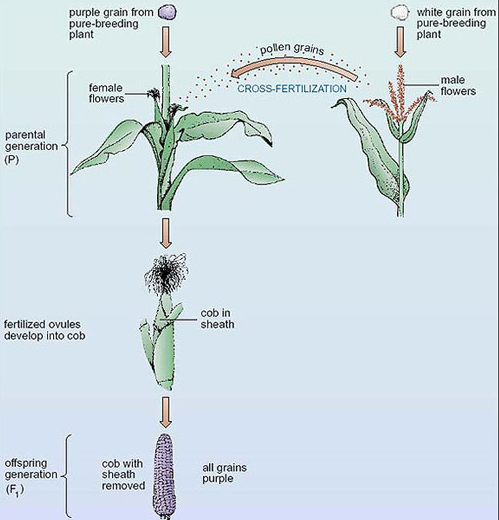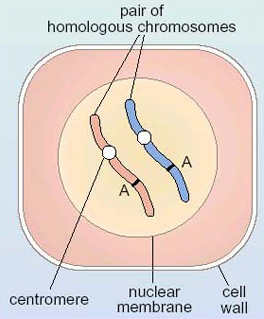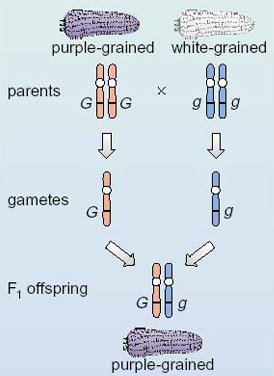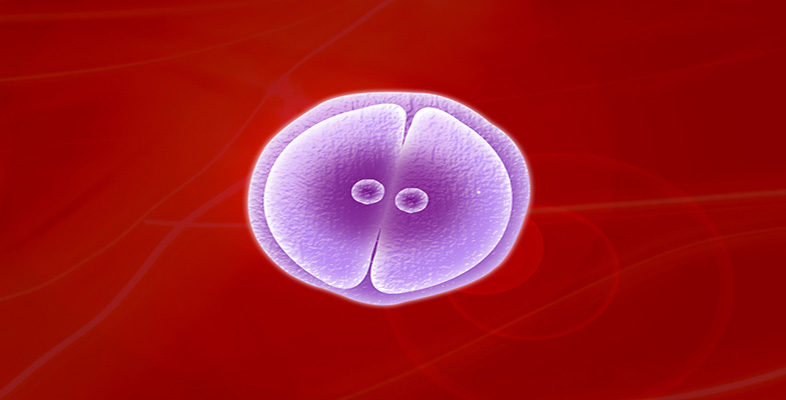3.2 A breeding experiment: stage one
In the first stage of the breeding experiment, shown in Figure 5, plants from the pure-breeding purple-grained variety are crossed with (fertilised by) plants from the pure-breeding white-grained variety. This can be done by artificially dabbing pollen grains from one plant onto the female flowers of another plant. These plants are the parental generation (abbreviated to P), and the cobs resulting from the cross are the first offspring generation or first filial (pronounced 'phil-ee-al') generation, (abbreviated to F1). The subsequent generations in such an experiment are called F2, F3, and so on. Incidentally, if you read information on seed packets, you may well be familiar with F1 hybrid seeds, which are the product of crossing two pure-breeding parental varieties.
Returning to our maize cross (Figure 5), the most striking observation is that these cross-fertilisations result in F1 cobs all of which have purple grains. On average, each cob contains 500 grains, so examining the grains on only one cob means that we are examining a large number of offspring (or fertilisations).

Two important features of the results of this cross should be noted:
-
No F1 cobs have any white grains. This is true even if we examine large numbers of F1 cobs. Hence, one of the two characters present in the parental generation, white grain colour, has vanished in the F1 offspring generation.
-
It doesn't matter which way round the cross is carried out; that is, the result is the same whether the pollen comes from the purple-grained variety and the ovules from the white-grained variety, or vice versa. This rules out the possibility that grain colour is determined by the plant on which the cob has grown.
Now that we have examined the phenotype of the grains in the breeding experiment, we will explore what is happening at the level of the gene. We can consider a gene as a small section of the DNA in a chromosome, which issues instructions for a specific phenotypic character such that a maize grain is either purple (presence of purple pigment) or white (absence of purple pigment); for brevity it can be called the gene for grain colour. Most importantly for understanding the patterns of inheritance of genes, it is known that a gene has a particular location on a chromosome, such as band A in Figure 6. As this figure shows, a diploid cell contains two copies of a gene for a particular character situated at corresponding locations on the two homologous chromosomes. The technical term for the location of a gene on a chromosome is locus (plural loci).
Question 4
Where do each of these two copies of a gene in a diploid cell come from?
Answer
One comes from the female gamete and the other from the male gamete. (Fertilisation restores the chromosomes as homologous pairs, as shown in Figure 3.)
Question 5
Why is the outcome of the breeding experiment described above the same regardless of which of the parental phenotypes provides the ovules and which provides the pollen?
Answer
The simplest explanation is that the instructions that a gene issues are the same, irrespective of whether the gene is from the male or female parent.
Each gene can exist in one or more forms; each form is a different allele (pronounced 'a', as in apple, 'leel'). The existence of alleles of a gene is a powerful source of variation. It is conventional in genetics to represent each allele by a letter (either upper or lower case), printed in italics; alleles are given the same letter symbol to show that they are forms of the same gene. In the case of grain colour we will use the letter G (for grain) for the allele that is associated with purple grains and g for the different allele that is associated with white grains.
The terms 'allele' and 'gene' can be confusing because the terms are used interchangeably in some situations. For example, the 'allele for purple grain' and the 'gene for purple grain' both refer to the same thing in an interchangeable way. This stems from the fact that the forms (alleles) of any gene are of course genes themselves.
Now consider what happens at the gene level when we cross the pure-breeding purple-grained plant with the pure-breeding white-grained plant. We will designate the two copies of the gene in the purple-grained parent as GG and the two copies of the gene in the white-grained parent as gg, as shown in Figure 7. (The reason for this designation will become clear later in the section.) Note the convention of the multiplication sign to represent a breeding cross. Of course, the gametes contain a copy of each of the other maize genes too, but here we are considering only the gene for grain colour.
Question 6
Looking at Figure 7, what are the genotypes of the gametes produced by each parent?
Answer
G and g. Gametes from the purple-grained parent all contain the G allele and those from the white-grained parent all contain the g allele.
Recall from Figure 3 that meiosis ensures that each gamete contains one member of each homologous pair of chromosomes and hence only one copy of each gene.
Question 7
What would be the possible genotypes of the offspring of such a cross?
Answer
They would all be Gg or g G, and these are the same genotype.
The convention is to write the allele with the capital letter first, so the genotype of all the F1 offspring would be written as Gg. Notice that not only do all the F1 offspring have the same genotype, Gg, but that this genotype is different from that of either parent. Where the two copies of a gene are different, as in the offspring of this cross, they are said to be heterozygous (pronounced 'het-er-oh-zye-guss') and the individual is referred to as a heterozygote (pronounced 'het-er-oh-zye-goat') for that particular gene. When the two copies of the gene are the same (as in the case of each parent), they are said to be homozygous and the individual is a homozygote for the gene for grain colour.


But what is the phenotype of the F1 offspring with the heterozygous genotype Gg? You may recall (Figure 5) that the phenotype of all the F1 offspring of this cross was purple. The character that is expressed, or manifest, in the heterozygote, purple grain in this case, is said to be the dominant character because it masks the presence of the alternative character, white grain. The character that is not expressed in the heterozygote is said to be recessive. In this case, white grain is recessive to, or masked by, the dominant character, purple grain. Strictly speaking, it is the phenotype — rather than the allele — that is dominant or recessive; however, alleles are usually referred to as being dominant or recessive on the basis of the associated phenotype.
Activity 4
Match each of the terms (a)-(g) with one of the descriptions (i)-(vii).
(a) F1; (b) alleles; (c) locus; (d) heterozygous; (e) homozygote; (f) dominant; (g) recessive.
-
An individual in which both copies of the gene are the same.
-
The alternative forms of a gene.
-
The generation derived from a mating between two pure-breeding varieties.
-
The location of a gene on a chromosome.
-
A phenotype that masks the presence of the allele for a contrasting character.
-
A genotype with two different alleles of a gene.
-
A phenotype not expressed in the heterozygote.
Answer
The matches between the terms and the descriptions are as follows: (a) (iii); (b) (ii); (c) (iv); (d) (vi); (e) (i); (f) (v); (g) (vii).
